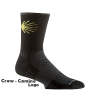Hi
@Rossco and welcome to the Forum
I'm a sock fanatic and have used various configurations of toe socks very successfully and blister free for many years. Not sure where you are located (I'm in Australia) but
Injinji Toe Socks website is a good place to start your research. This comparison chart shows you all the different materials, lengths and styles available. This is not the only company and there are many other excellent retailers who stock a wide range including
ToeSox and
ToeToe.
I use the toe socks on their own, as liners and also have compression pairs for travelling as well as post walk recovery. I have used merino wool fibre, Nuwool, CoolMax as well as silk and silk blend. On the Camino Francés in April/May I alternated the Injinji Nuwool MidWeight Crew Socks with padded cushioning (Nuwool is a blend of merino wool, nylon and spandex and has great wicking properties ) with a silk/merino blend liner ToeToe sock under my Meindl trekking socks.
You may also want to check out
blister prevention strategies on podiatrist Rebecca Ruston's website. Foot problems are a complex science and your blisters may need a strategy that includes more than just toe socks.
Good luck with your research and I hope that you find a solution that lets your next Camino be blister free.


























